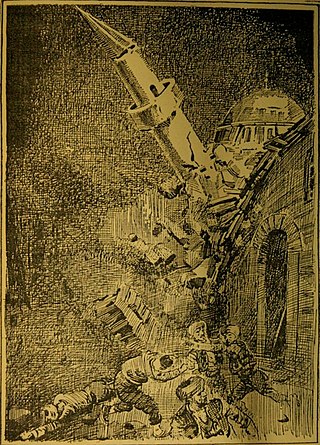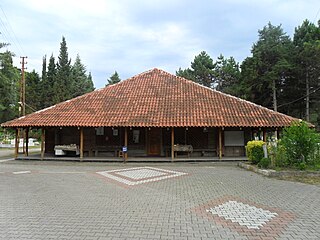
Rumelihisarı or Boğazkesen Fortress is a medieval Ottoman fortress located in Istanbul, Turkey, on a series of hills on the European banks of the Bosphorus. The fortress also lends its name to the immediate neighborhood around it in the city's Sarıyer district.

Samsun, historically known as Sampsounta and Amisos, is a city on the north coast of Turkey and a major Black Sea port. Over 700,000 people live in the city. The city is the capital of Samsun Province which has a population of over 1,350,000. The city is home to Ondokuz Mayıs University, several hospitals, three large shopping malls, Samsunspor football club, an opera house and a large and modern manufacturing district. A former Greek settlement, the city is best known as the place where Mustafa Kemal Atatürk began the Turkish War of Independence in 1919.

Ordu or Altınordu is a port city on the Black Sea coast of Turkey, historically also known as Cotyora or Kotyora, and the capital of Ordu Province. The city forms the urban part of the Altınordu district, with a population of 235,096 in 2023.

Merzifon is a town in Amasya Province in the central Black Sea region of Turkey. It is the seat of Merzifon District. Its population is 61,376 (2021). The mayor is Alp Kargı (CHP).

The large Fatih Mosque is an Ottoman mosque off Fevzi Paşa Caddesi in the Fatih district of Istanbul, Turkey. The original mosque was constructed between 1463 and 1470 on the site of the Church of the Holy Apostles. Seriously damaged in the 1766 earthquake, it was rebuilt in 1771 to a different design. It is named after the Ottoman sultan Mehmed the Conqueror, known in Turkish as Fatih Sultan Mehmed, who conquered Constantinople in 1453.

The Eyüp Sultan Mosque is a mosque in Eyüp district of Istanbul, Turkey. The mosque complex includes a mausoleum marking the spot where Ebu Eyüp el-Ansari, the standard-bearer and companion of the Islamic prophet Muhammad, is said to have been buried. On a much older site, the present building dates from the beginning of the 19th century.

The siege of Rhodes of 1522 was the second and ultimately successful attempt by the Ottoman Empire to expel the Knights of Rhodes from their island stronghold and thereby secure Ottoman control of the Eastern Mediterranean. The first siege in 1480 had been unsuccessful. Despite very strong defenses, the walls were demolished over the course of six months by Turkish artillery and mines.

Selimiye Mosque, historically known as Cathedral of Saint Sophia or Ayasofya Mosque, is a former Christian cathedral converted into a mosque, located in North Nicosia. It has historically been the main mosque on the island of Cyprus. The Selimiye Mosque is housed in the largest and oldest surviving Gothic church in Cyprus possibly constructed on the site of an earlier Byzantine church.

The 1509 Constantinople earthquake or historically Kıyamet-i Sugra occurred in the Sea of Marmara on 10 September 1509 at about 22:00. The earthquake had an estimated magnitude of 7.2 ± 0.3 on the surface-wave magnitude scale. A tsunami and 45 days of aftershocks followed the earthquake. The death toll of this earthquake is poorly known; estimates range between 1,000 and 13,000.

The architecture of Istanbul describes a large mixture of structures which reflect the many influences that have made an indelible mark in all districts of the city. The ancient part of the city is still partially surrounded by the Walls of Constantinople, erected in the 5th century by Emperor Theodosius II to protect the city from invasion. The architecture inside the city proper contains buildings and structures which came from Byzantine, Genoese, Ottoman, and modern Turkish sources. The city has many architecturally significant entities. Throughout its long history, Istanbul has acquired a reputation for being a cultural and ethnic melting pot. As a result, there are many historical mosques, churches, synagogues, palaces, castles and towers to visit in the city.
The 1943 Tosya–Ladik earthquake occurred at 01:20 local time on 27 November, near Tosya, Kastamonu Province, in northern Turkey. The earthquake had an estimated moment magnitude of 7.5–7.7 and a maximum felt intensity of XI (Catastrophic) on the MSK-64 scale. Its effects were observed for over 45,000 km2. The earthquake was felt in Trabzon, Isparta, Elazığ, Zonguldak and Yozgat. Damage was seen in Kastamonu, Çankırı, Çorum, Amasya, Samsun, Tokat, Sinop and Ordu. As a result of the earthquake, more than 2,500 were killed and 5,000 were injured.

The Castle of Kars is a former fortification located in Kars, Turkey. It is also known under the name İç Kale.

The Muradiye Mosque is a 15th-century Ottoman mosque in Edirne, Turkey. The building is noted for the tiles that decorate the mihrab and the walls of the prayer hall.

Gaziantep Castle is a castle on top of a mound in the centre of Gaziantep, Turkey. First used as an observation point during the Hittite Empire, it was expanded into a castle during Roman rule. The castle was severely damaged by earthquakes in February 2023.

Alaaddin Mosque is a historical mosque in Sinop City, Sinop Province, Turkey.

Göğceli Mosque is a historic log mosque situated inside the Göğceli Cemetery in Çarşamba, Samsun, northern Turkey. Built during the Seljuk Empire period in the 13th century, the log mosque was constructed without the use of nails.

Saathane Square is a public square in Samsun's Ilkadim district and takes its name from the Samsun Clock Tower which is located in the center of the square. Along with Republic Square (Samsun), it is one of two important and historical squares in Samsun. The square is bounded by the headquarters of the Samsun Metropolitan Municipal Government, Central Great Mosque (Samsun), Taş Han, the Şifa Bath and the Medrese Mosque.
Samsun was one of the four Durandal-class destroyers purchased by the Ottoman Empire from France in 1907. The ship served in the Ottoman Navy during the Italo-Turkish War, the Balkan Wars and World War I.

Site Mosque is a mosque located in Ilkadim district of Samsun. The mosque is a prominent architectural landmark in the city center due to both its location and unique architectural style. It was built between 1976 and 1985 as part of a redevelopment of the city center. Plans were announced in 2022 to demolish the mosque as part of an urban renewal campaign of Samsun's City Center.























